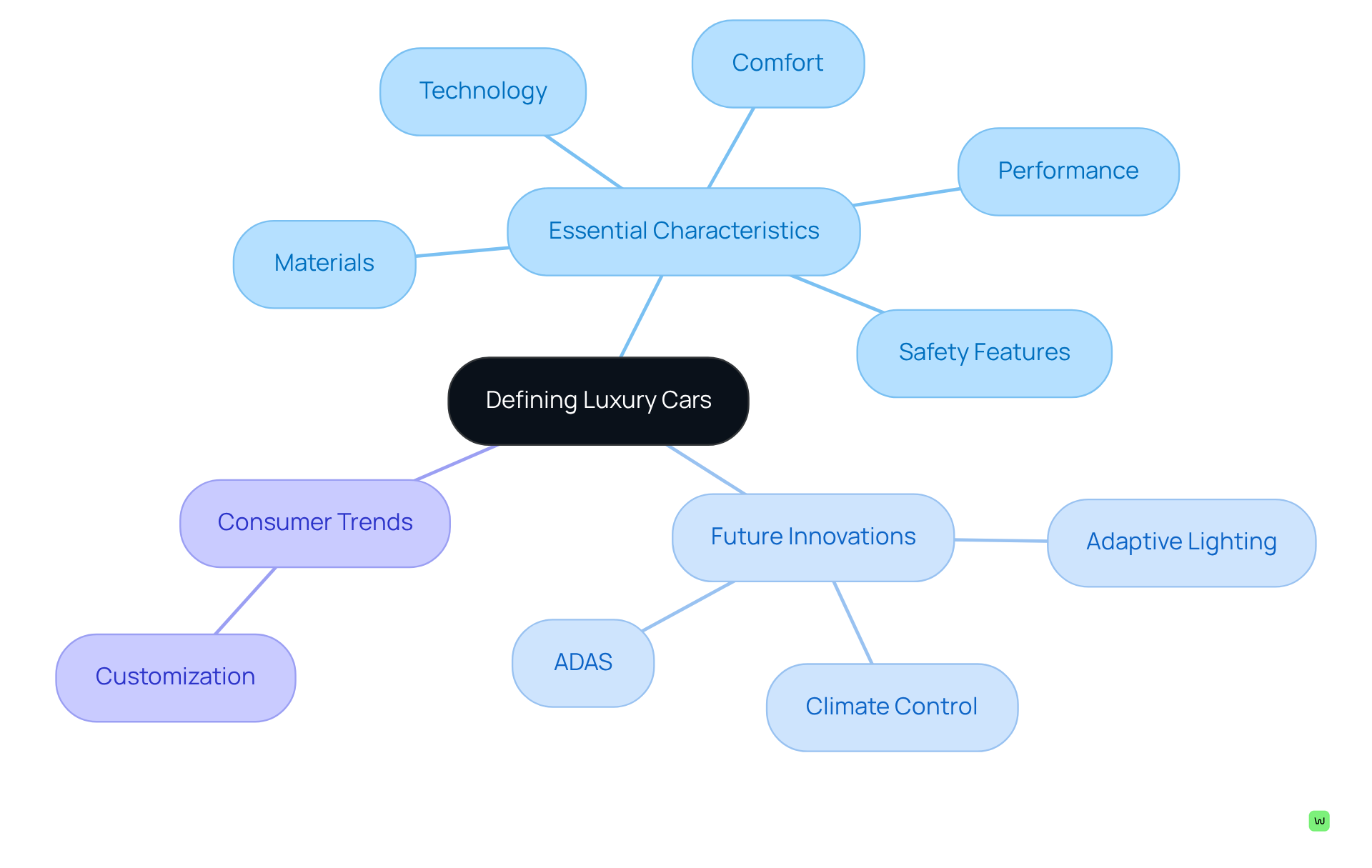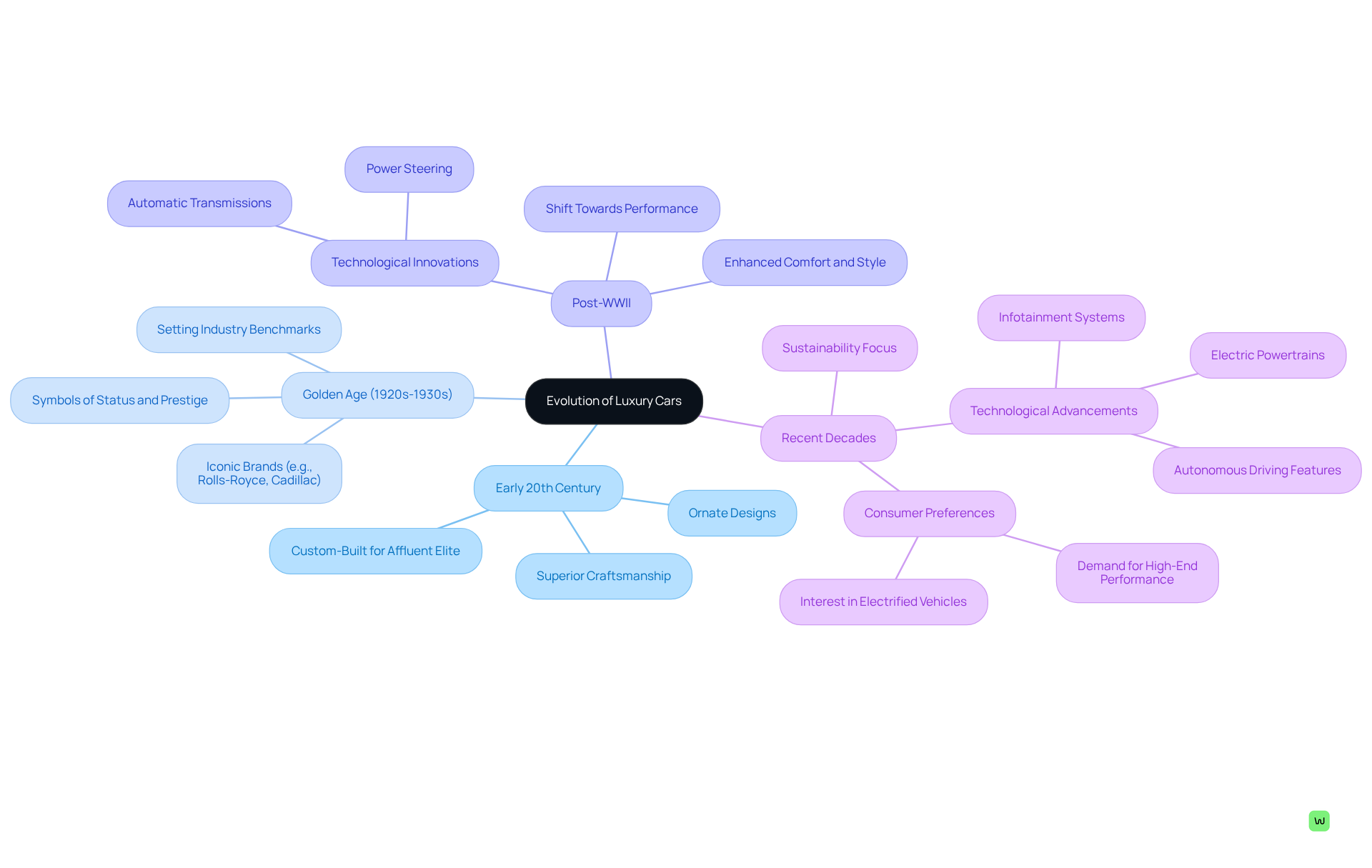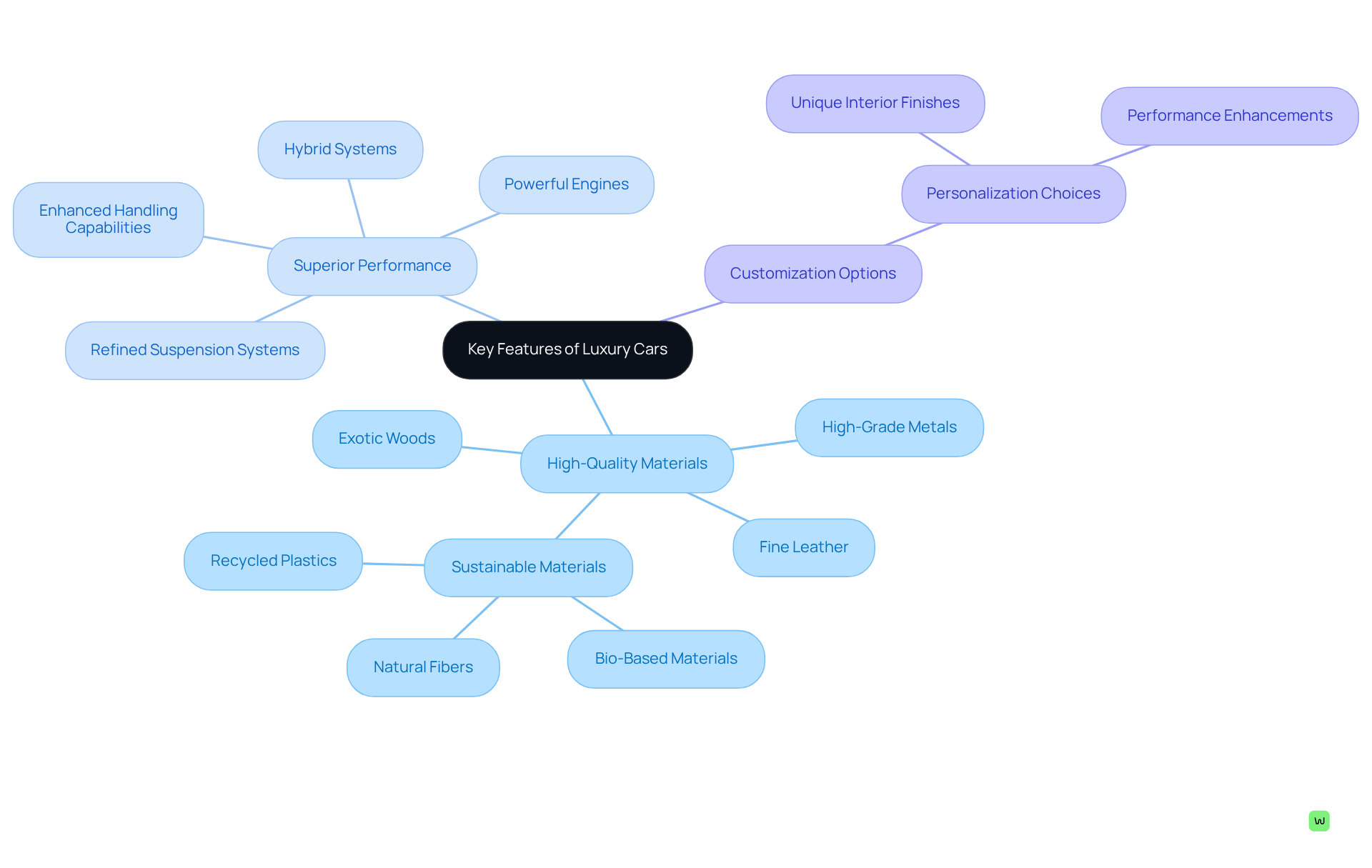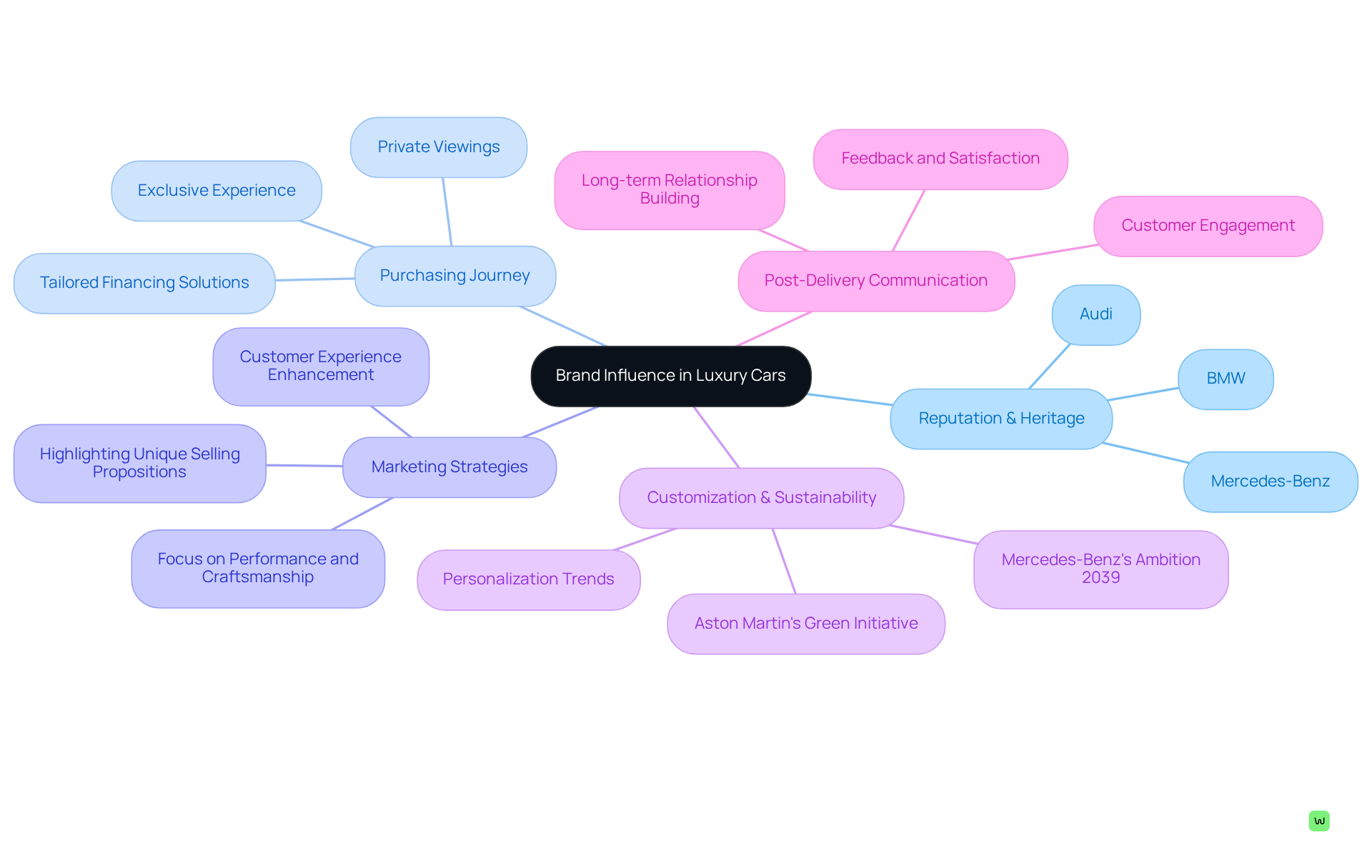Overview
This article delves into the defining characteristics and evolution of luxury cars, showcasing their essential features such as unparalleled comfort, cutting-edge technology, and extensive customization options. Have you ever wondered what sets luxury vehicles apart in today's market? By tracing the historical development of these automobiles, we can see the profound impact of technological advancements and the surging consumer demand for personalized and sustainable choices within the high-end automotive sector.
Luxury cars are not just about transportation; they symbolize status and sophistication. Key attributes include:
- Comfort: Exceptional ride quality and interior refinement.
- Technology: Integration of the latest innovations for enhanced driving experience.
- Customization: Tailored options that cater to individual preferences.
As we explore these facets, it becomes evident that the luxury automotive market is evolving rapidly, driven by consumer desires for both personalization and sustainability. Understanding these trends is crucial for industry stakeholders aiming to meet the expectations of discerning buyers.
Introduction
Luxury cars have long epitomized sophistication and innovation, captivating the imagination of automotive enthusiasts and affluent consumers alike. As the market evolves, these vehicles are increasingly characterized not only by plush interiors and cutting-edge technology but also by a growing demand for personalization and sustainability. What challenges do luxury brands encounter as they strive to balance tradition with the modern expectations of consumers? This exploration delves into the defining characteristics, historical evolution, and future trends that shape the luxury car landscape.
Defining Luxury Cars: Essential Characteristics
Luxury cars are distinguished by their exceptional comfort, cutting-edge technology, and high-quality materials. These vehicles typically feature plush interiors, adorned with premium leather, elegant wood accents, and state-of-the-art infotainment systems. Advanced safety features and superior performance capabilities—such as powerful engines and refined handling—further enhance their appeal. The essence of a luxury car transcends mere cost; it encompasses the overall experience, characterized by a smooth ride, a quiet cabin, and personalized customer service.
Looking ahead to 2025, the premium car market is set to unveil innovations like adaptive lighting, climate control systems, and advanced driver-assistance systems (ADAS). These advancements not only improve safety but also elevate the user experience. Prominent brands such as Mercedes-Benz, Aston Martin, Tesla, and Bugatti lead the charge in incorporating these technologies into luxury cars, ensuring that comfort and innovation remain central to high-end automotive design.
Research indicates that nearly 84 percent of high-end car buyers prioritize the ability to personalize their vehicles. This reflects a growing trend towards customization within the industry. As producers continue to innovate, the concept of opulence is evolving, aligning with consumer expectations for both performance and sustainability. Are you ready to explore these advancements in luxury automotive design?

The Evolution of Luxury Cars: A Historical Perspective
The development of luxury cars began in the early 20th century, when automobiles were custom-built for the affluent elite. These vehicles showcased ornate designs and superior craftsmanship, marking a significant era in automotive history. The 1920s and 1930s are often referred to as the Golden Age of luxury cars, with iconic brands such as Rolls-Royce and Cadillac exemplifying opulence and setting industry benchmarks. During this time, luxury cars transcended their role as mere modes of transport; they became symbols of status and prestige.
In the aftermath of World War II, the automotive landscape shifted towards performance and technological innovation. This era saw the emergence of automatic transmissions and power steering, which enhanced the driving experience and made luxury cars more accessible to a broader audience. The focus on performance was complemented by a growing emphasis on comfort and style, as manufacturers aimed to meet the evolving tastes of affluent consumers.
In recent decades, the premium car segment has undergone a significant transformation driven by technological advancements. Today’s luxury cars incorporate advanced infotainment systems, electric powertrains, and autonomous driving features, showcasing a harmonious blend of tradition and innovation. This evolution not only reflects shifting consumer preferences but also underscores the industry's commitment to sustainability and cutting-edge innovations.
Case studies from the 1920s and 1930s illustrate how brands like Bentley and Maserati laid the groundwork for high-end performance. Meanwhile, the introduction of features such as advanced safety systems and connectivity options in modern models highlights the ongoing evolution of premium vehicles. As the market continues to expand, the demand for luxury cars that seamlessly merge performance and advanced innovation remains a driving force in the automotive sector.

Key Features of Luxury Cars: What Sets Them Apart
Luxury cars are distinguished by several defining features that elevate them above standard vehicles:
-
High-Quality Materials: Premium materials such as fine leather, exotic woods, and high-grade metals significantly enhance the tactile experience and overall aesthetic appeal. Equipped with state-of-the-art advancements like adaptive cruise control, lane-keeping assist, and sophisticated AI-driven infotainment systems, luxury cars offer convenience and improve safety, illustrating the industry's shift towards advanced innovations.
-
Superior Performance: Luxury cars provide a smooth and responsive driving experience, thanks to powerful engines, refined suspension systems, and enhanced handling capabilities. The inclusion of hybrid systems further boosts performance while promoting sustainability.
-
Customization Options: Many high-end brands offer extensive personalization choices, allowing purchasers to tailor their automobiles to their preferences. From unique interior finishes to performance enhancements, each car can reflect the owner's individuality.
As the high-end automobile market evolves, the integration of sustainable materials and advanced technologies continues to redefine opulence, catering to the growing demand for vehicles that combine elegance with environmental responsibility. The global high-end car market is projected to grow at a compound annual growth rate (CAGR) of 6.9% from 2023 to 2030, driven by these advancements and the increasing number of ultra-high-net-worth individuals (UHNWIs) seeking bespoke experiences.

Brand Influence and Customer Experience in Luxury Cars
Brand influence is pivotal in the luxury car market, where reputation and heritage significantly shape consumer preferences. Leading brands like Mercedes-Benz, BMW, and Audi have established dominance by consistently delivering high-quality vehicles and exceptional customer service. The purchasing journey for high-end vehicles is designed to be exclusive and personalized, often featuring custom services such as private viewings and tailored financing solutions.
High-end brands also invest significantly in marketing strategies that highlight their unique selling propositions, including performance, craftsmanship, and innovation. This focus on brand identity and customer experience not only fosters loyalty but also enhances the perceived value of high-end vehicles, making them increasingly appealing to consumers.
As the market evolves, the growing trend towards customization and personalization, alongside sustainability initiatives like Aston Martin's Green initiative and Mercedes-Benz's Ambition 2039, will further shape consumer expectations and the high-end automotive landscape. Notably, statistics reveal that 49 percent of buyers of luxury cars would prefer comprehensive garage maintenance services, underscoring the importance of a hassle-free ownership experience.
Moreover, maintaining communication with customers post-delivery is essential for nurturing long-term relationships and enhancing overall satisfaction. How can brands ensure they meet these evolving expectations? By prioritizing customer engagement and adapting to market trends, they can solidify their position in this competitive landscape.

Conclusion
Luxury cars represent more than mere transportation; they embody a unique blend of comfort, technology, and craftsmanship that appeals to discerning consumers. The evolution of these vehicles—from their opulent beginnings in the early 20th century to the innovative designs anticipated by 2025—highlights a continuous journey toward redefining luxury. As the automotive landscape shifts, the significance of personalization and sustainability has become paramount, reflecting a broader understanding of luxury in today's world.
Several key characteristics define luxury vehicles:
- High-quality materials
- Superior performance
- Strong emphasis on customization
Innovations such as advanced driver-assistance systems and electric powertrains are shaping the future, with brands like Mercedes-Benz and Tesla leading the integration of cutting-edge technology with traditional luxury. Furthermore, the importance of brand reputation and customer experience cannot be overstated, as these elements significantly influence consumer preferences and drive sales in the high-end market.
Ultimately, the luxury car market is poised for growth, driven by evolving consumer expectations and technological advancements. As brands adapt to these changes, they must prioritize customer engagement and sustainability to remain relevant. The future of luxury cars promises not only enhanced performance and elegance but also a deeper connection to the values of the modern consumer. Embracing these trends will ensure that luxury vehicles continue to captivate and inspire, solidifying their status as symbols of status and innovation in an ever-changing automotive landscape.
Frequently Asked Questions
What defines a luxury car?
Luxury cars are characterized by exceptional comfort, cutting-edge technology, and high-quality materials. They typically feature plush interiors with premium leather, elegant wood accents, and state-of-the-art infotainment systems, along with advanced safety features and superior performance capabilities.
What are some essential features of luxury cars?
Essential features of luxury cars include powerful engines, refined handling, a smooth ride, a quiet cabin, and personalized customer service.
What innovations can we expect in luxury cars by 2025?
By 2025, the premium car market is expected to introduce innovations such as adaptive lighting, advanced climate control systems, and advanced driver-assistance systems (ADAS), which will enhance safety and improve the user experience.
Which brands are leading in luxury car innovations?
Prominent brands such as Mercedes-Benz, Aston Martin, Tesla, and Bugatti are leading the incorporation of new technologies into luxury cars, focusing on comfort and innovation.
How important is personalization for high-end car buyers?
Research shows that nearly 84 percent of high-end car buyers prioritize the ability to personalize their vehicles, indicating a strong trend towards customization in the luxury car industry.
How is the concept of luxury evolving in the automotive industry?
The concept of luxury is evolving to align with consumer expectations for both performance and sustainability, as producers continue to innovate and adapt to changing market demands.




